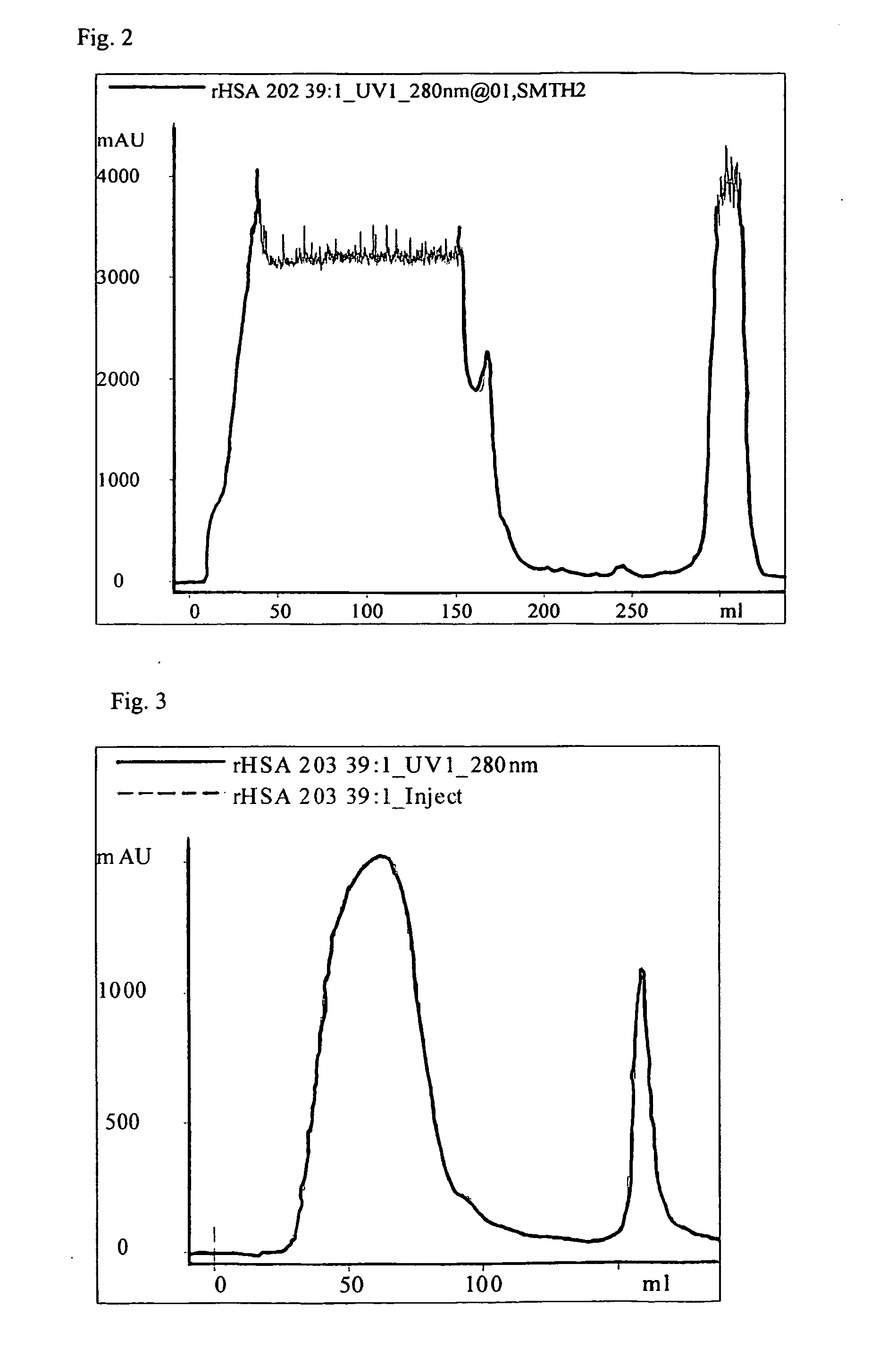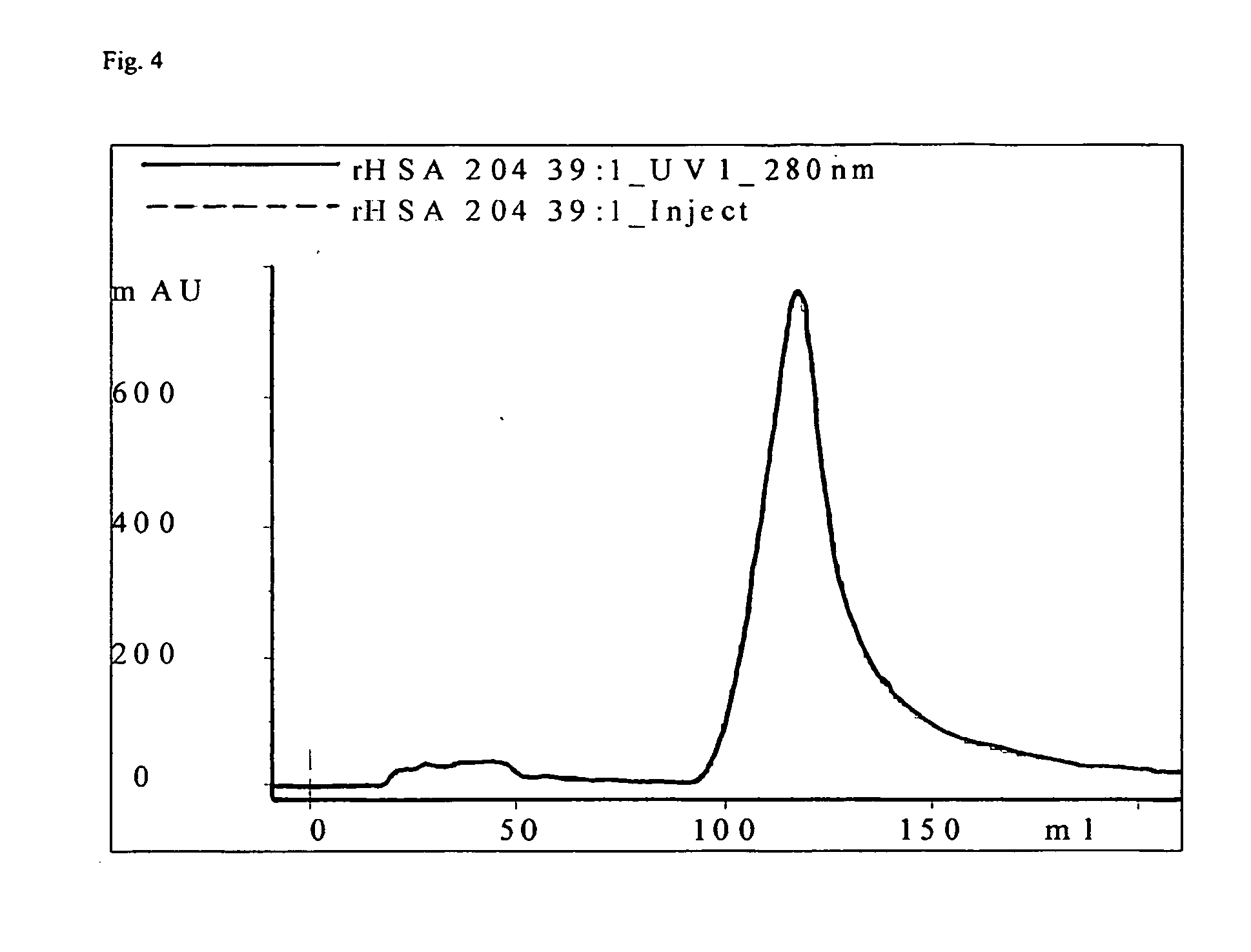[0035] In one embodiment of the
present method, the amount of cation
exchange matrix used in step (a) is about half the amount of HIC matrix used in step (b). Accordingly, one
advantage of the present invention is the outstanding binding capacity of the bimodal cation exchange matrix that allows a reduction in volume and therefore
operational costs as compared to conventional cation exchangers. In the presence of a high salt concentration, such as a
conductivity of about 25-30 mS / cm, the adsorption of commercially available SP
Sepharose for rHSA is about 2-4 mg / mL packed gel, while that of the high salt ligand prototype (FIG. 1A) has been shown to be at least 50 mg / mL. Accordingly, the use of the bimodal high salt ligand (HSL) clearly simplifies and improves the purification process significantly and reduces the cost of operation on large scale.
[0036] One embodiment of the
present method comprises heat treatment of the CCS before step (a). The heating can be performed directly i.e. while the host cells are still present or after removal thereof, such as by
centrifugation,
ultrafiltration or any other suitable method. The heating can be performed at 50-100° C. during a period of time of from 1 minute up to several hours, preferably at 60-75° C. for 20 minutes to 3 hours and most preferably at about 68° C. for about 30 minutes. The heating is conveniently performed in a water bath equipped with
thermostat. In one embodiment, a stabiliser is added before the heating, such as
sodium caprylate at a pH of about 6.0. Other stabilisers can be used, such as acetyltryptophan, organic carboxylic acids etc. After the heating, the pH of the CCS is preferably adjusted to a lower value suitable for the subsequent adsorption on a cation exchanger, such as pH 4.5.
[0037] In another embodiment of the
present method the product from step (a), i.e. the fraction bound to the column comprising the HSL-type matrix, is heat-treated before step (b). Preferably, a
reducing agent, such as
cysteine, is added. Other examples of useful reducing agents are mercaptoethanol, reduced
glutathione etc. The purpose of this is to facilitate the removal of coloured substances during step (b). This heat treatment is in general performed as described above, even though in the preferred embodiment, a slightly lower temperature such as about 60° C. for a slightly longer period of time such as about 60 minutes is used.
[0039] As is also mentioned above, step (c) of the present method utilises an
anion exchanger, preferably a weak
anion exchanger, for removing minor impurities from step (b), and especially to remove undesired compounds, such as low molecular weight pigments. The invention is not limited to use of any specific
anion exchanger material, as long as it exhibits a sufficient amount of ligands capable of binding compounds of
negative charge that are undesirable in the final rHSA product. The anion exchange chromatographic step can e.g. be performed at a pH of about 5.0-8.0 and a salt concentration of 0.01 to 0.2 M for removal of the impurities. As regards the matrix material, it may be of any organic or inorganic material, as discussed above. In one preferred embodiment, the matrix is comprised of
porous beads of cross-linked
agarose, such as
Sepharose™ from Amersham Biosciences (Uppsala, Sweden). The ligands attached thereto are weak anion exchangers, the binding group of which is for example a primary or secondary amine. Such a binding group can be attached to the matrix e.g. via an
alkyl chain with an
ether group closest to the matrix. The literature describes many ways of attaching a binding group to a matrix via spacers, arms etc, and as mentioned above the present invention is not limited to any specific structure. In an illustrative embodiment, an
agarose bead having ligands according to the following formula —O—CH2CH2—N+(C2H5)2H, e.g.
DEAE Sepharose™ from Amersham Biosciences, is used. This embodiment will result in rHSA in both the bound and the unbound fraction eluted from the column which, for some applications, is satisfactory.
[0040] However, an alternative embodiment which is more advantageous as far as purity of the final product is concerned, is using an
agarose bead having ligands that comprise two ester groups, and preferably also two hydroxyl groups. The binding group is then preferably primary amine. The
advantage with this embodiment is that the rHSA will be present only in the fraction that is moderately bound to the matrix, resulting in a much-improved purity and operational convenience. An illustrative general formula for this last mentioned embodiment is presented in FIG. 1, however it is to be understood that the present invention also comprises a method wherein similar structures are used in step (c).
 Login to View More
Login to View More 


